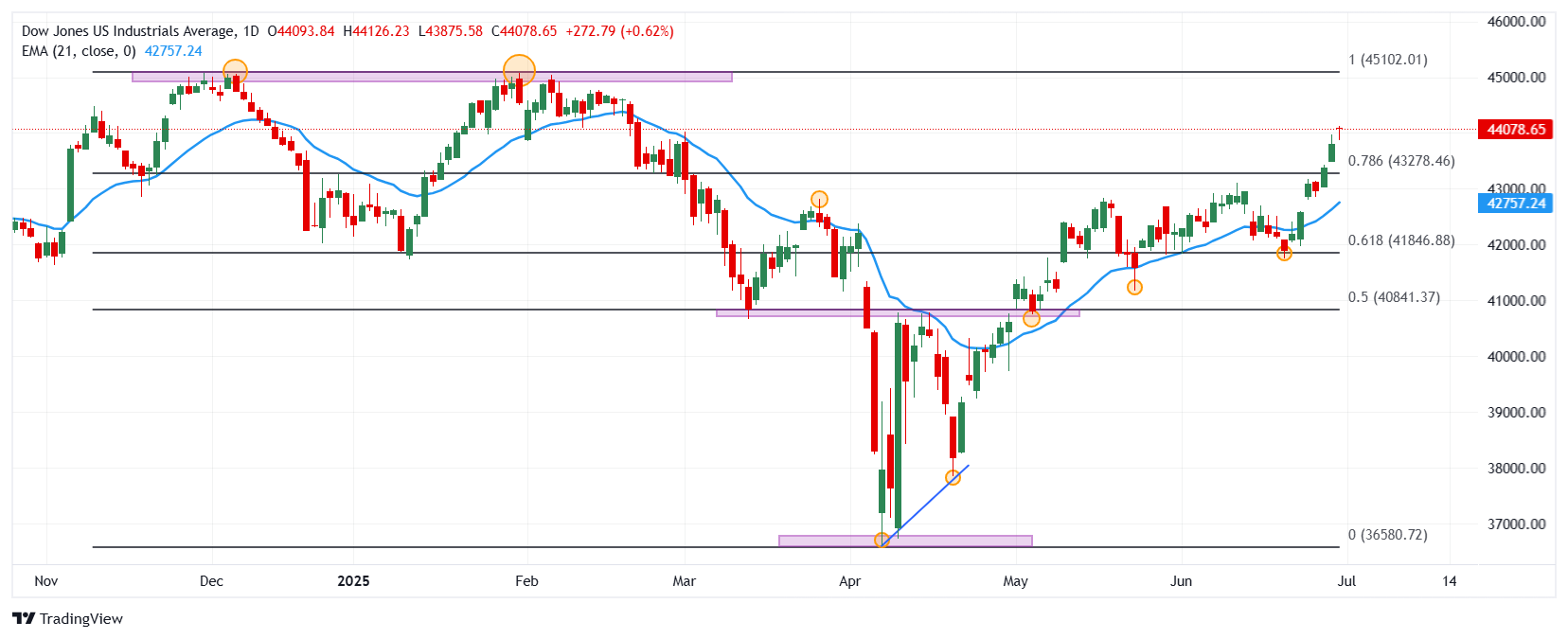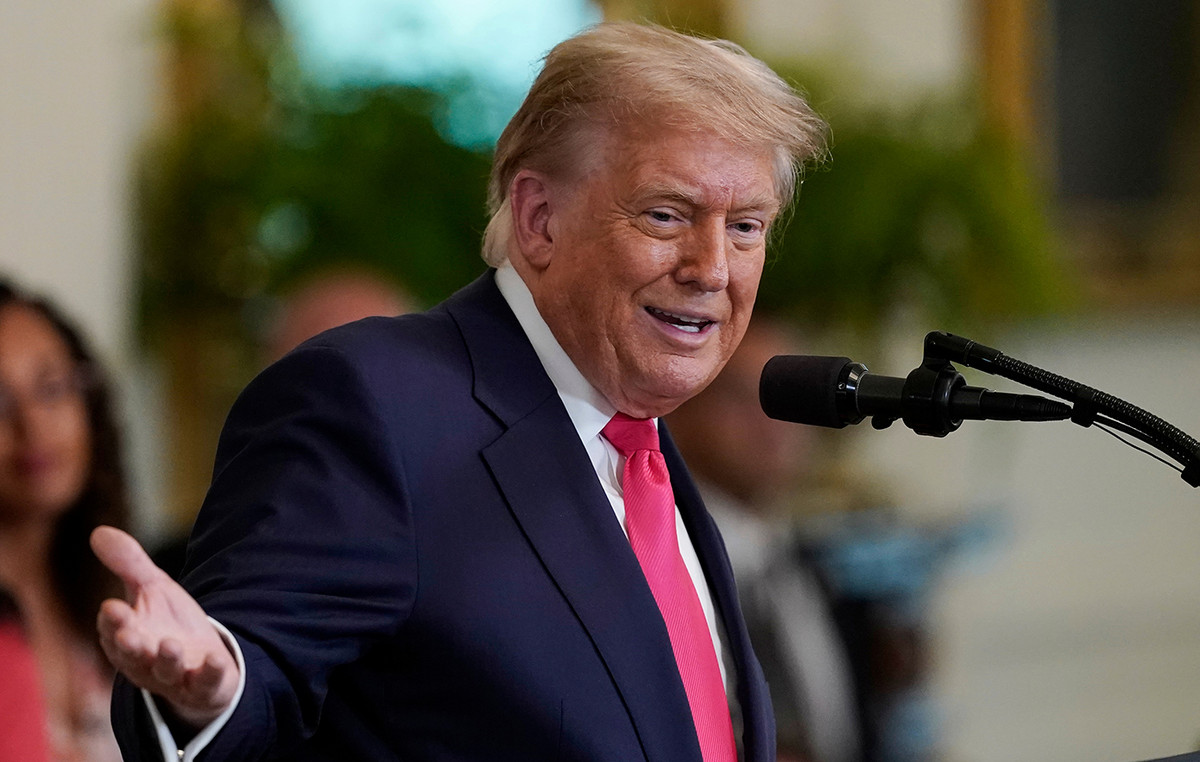- The Dow Jones wins 0.62% daily, consolidating at maximum of February 21 in 44,126.
- The Nasdaq 100 advances 0.67% today, establishing a new historical maximum in 22,717.
- The S&P 500 rises 0.58% on Monday, registering a new historical maximum in 6,212, driven by Hewlett Packard (HPE).
- The US economic agenda contemplates the statements of the president of the FED tomorrow, Jerome Powell
- The operators will be attentive to the ISM manufacturing PMI, to be published on Tuesday.
The Dow Jones established a minimum of the day in 43,875, attracting buyers who promoted the maximum index of February 21 in 44,126.
The Dow Jones industrial average began operating at 44,093, while the Nasdaq 100 technological index opened at 22,632. The S&P 500 began negotiations in 6,191, registering new historical maximums for the second consecutive day.
Goldman Sachs and Verizon take Dow Jones to maximums of more than four months
The Dow Jones index rises 0.62% in the day, operating at this time over 44,078.
Goldman Sachs (GS) titles advance 2.45% on the first day of the week, registering new historical maximums at $ 714.30, extending a streak of eight consecutive days with profits.
In the same tonic, Verizon Communications (VZ) rebukes 2.27% daily, reaching maximum of June 12 in 43,32 $, signing its second consecutive session upwards.
The Dow Jones wins 272 points, reaching maximums of February 21 in 44,126.
The Nasdaq marks new historical maximums promoted by Strategy Incorporated and Applovin Corporation
The Nasdaq 100 technological index rebounds 0.67% daily, reaching new historical maximums at 22,717.
Strategy Incorchase titles (MSTR) earn 5.30% daily, visiting May 22 at $ 407.39, ending with two consecutive days down.
On the other hand, the values of APPLOVIN COORPORATION (APP), rise 4.88% today, consolidating at maximum June 18 in 361.76 $.
In this context, the Nasdaq 100 advances 151 points, currently quoting about 22,677, establishing a new historical maximum in 22,717.
The S&P 500 records new historical maximums animated by Hewlett Packard and First Solar
The actions of First Solar, INC (FSLR) have a gain of 8.81% in the day, exceeding maximum of June 17 in 167.79 $. On the other hand, Hewlett Packard (HPE) titles rebound 11.08% today, reaching maximums not seen since February 24 at $ 24.97, spinning two consecutive sessions in positive terrain.
The focus of investors will be on the manufacturing PMI of the June ISM, as well as in the comments of the president of the Federal Reserve, Jerome Powell
The S&P 500 goes up 35 points on the first day of the week, marking a new historical maximum in 6,212.
Technical Analysis of Dow Jones
The Dow Jones reacted upwards from a short -term support given by the minimum of June 19 in 41,971. The following important support is located in 40,747, a pivot point of May 6, in convergence with the 50% fibonacci setback. To the north, the important resistance is 45,068, maximum of January 31.
Dow Jones daily graphics

Dow Jones Faqs
The Dow Jones Industrial Avenge, one of the oldest stock market indexes in the world, consists of the 30 most negotiated values in the United States. The index is weighted by the price instead of capitalization. It is calculated by adding the prices of the values that compose it and dividing them by a factor, currently 0.152. The index was founded by Charles Dow, also founder of the Wall Street Journal. In recent years it has been criticized for not being sufficiently representative, since it only follows 30 companies, unlike broader rates such as S&P 500.
There are many factors that promote the Dow Jones Industrial Average (DJIA) index. The main one is the added performance of the companies that compose it, revealed in the quarterly reports of business benefits. The American and world macroeconomic data also contribute, since they influence investor confidence. The level of interest rates, set by the Federal Reserve (FED), also influences the DJia, since it affects the cost of credit, on which many companies depend largely. Therefore, inflation can be a determining factor, as well as other parameters that influence the decisions of the Federal Reserve.
Dow’s theory is a method to identify the main trend of the stock market developed by Charles Dow. A key step is to compare the direction of the Dow Jones Industrial Avenge (DJIA) and the Dow Jones Transportation Average (DJTA) and just follow the trends in which both move in the same direction. The volume is a confirmation criterion. The theory uses elements of maximum and minimum analysis. Dow’s theory raises three phases of the trend: accumulation, when intelligent money begins to buy or sell; Public participation, when the general public joins the trend; and distribution, when intelligent money abandons the trend.
There are several ways to operate with the DJ. One of them is to use ETF that allow investors to negotiate the DJ as a single value, instead of having to buy shares of the 30 companies that compose it. An outstanding example is the SPDR Dow Jones Industrial Avenge ETF (day). Future contracts on the DJ allow the specular operators about the future value of the index and the options provide the right, but not the obligation, to buy or sell the index at a predetermined price in the future. Investment funds allow investors to buy a part of a diversified portfolio of DJ values, which provides exposure to global index.
Source: Fx Street
I am Joshua Winder, a senior-level journalist and editor at World Stock Market. I specialize in covering news related to the stock market and economic trends. With more than 8 years of experience in this field, I have become an expert in financial reporting.







